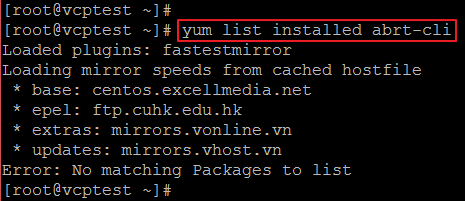Overview
The daemon runs silently in the background most of the time, and springs into action when an application crashes or a kernel oops is detected.
The daemon then collects the relevant problem data such as a core file if there is one, the crashing application's command-line parameters, and other data of forensic utility.
Verify Installed Status
Before you install the “abrt-cli” package, verify if the package is already installed, to verify package installation status, run the command;yum list installed abrt-cli
Install Package
After verification and if the “abrt-cli” package is not installed; install the package, to install run the command;yum install abrt-cli -y -q
Check Service Status
After installing the package check the abrtd service status, run the command;systemctl status abrtd
Start Service
Next step is to start the service to start, run the command;start abrtd && systemctl status abrtd -l
ABRT Default Configuration
ABRT Configuration file “/etc/abrt/abrt.conf”, with default setting can be retrieved with the below command;egrep -v '^#|^$|^;' /etc/abrt/abrt.conf
| Attribute | Default |
|---|---|
| MaxCrashReportsSize | 1000 MB |
| DumpLocation | /var/spool/abrt |
| DeleteUploaded | no |
| AutoreportingEvent | report_uReport |
| AutoreportingEnabled | no |
| PrivateReports | yes |
Enable Auto Reporting
Next, step is the enable auto reporting, run the command;abrt-auto-reporting enabled
Configure SELinux – ABRT
Only when the default “DumpLocation” in the configuration is changed, SELinux has to be configured. In case you change the “DumpLocation” is changed, SELinux has to be reconfigured to enable write.Default directory is “/var/spool/abrt”; and by default its comment in the configuration file.
egrep -i -B2 "#DumpLocation" /etc/abrt/abrt.conf
Listing Dump Files
To list the dump files generated, in the default folder, run the command;ls -la /var/spool/abrt
View SELinux Setting
To view the current SELinux configured for “abrt” run the command below;getsebool -a | grep abrt
Modify SELinux Setting
To modify SELinux attribute for “abrt”, run the command below;setsebool -P abrt_anon_write 1 && getsebool -a | grep abrt
ABRT CLI Commands
abrt-cli commands are listed in the below table with its purpose.| Argument | Purpose |
|---|---|
| list | Lists problems and views the problem data. |
| report | Analyzes and reports problems. |
| rm | removes unneeded problems. |
| info | Provides information about a particular problem. |
| status | Short info about issues (count), if any. |
ABRT Issue – Listing
To lists problems, run the command;abrt-cli list
ABRT Issue – Detailed Listing
To retrieve detailed information about the aborted issue(s), run the command;abrt-cli list -vn –detailed
ABRT Issue – Reporting
To retrieve detailed information about the aborted issue(s), run the command;abrt-cli report /var/spool/abrt/oops-2016-04-29-00:05:02-1148-0
ABRT Issue – Info
To retrieve issue info, run the command;abrt-cli info /var/spool/abrt/oops-2016-04-29-00:05:02-1148-0
ABRT Issue – Status
To retrieve issues short info, run the command;abrt-cli status
ABRT Issue – Remove
To remove a specific issue, run the command;abrt-cli remove /var/spool/abrt/oops-2016-04-29-00:05:02-1148-0
Note: Once you remove the dump file and directory is deleted automatically.
ABRT Issue – Process
To process issue(s), run the command;abrt-cli process
Note: you can remove, report, get information or skip for each issue created and stored.
Slideshare Information
Step by step guide with screenshots is uploaded to slideshare.

















No comments:
Post a Comment